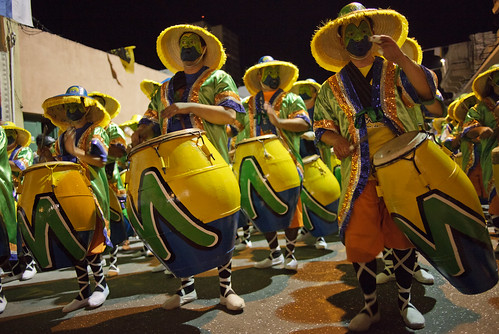article from February 15, 2011
by Julie R Butler
The preliminaries
Several youth events occur before the official beginning of Uruguay’s Carnival in January that nurture up-and-coming talent. Las murgas jovenes are a series of contests that occur in November, and el carnaval de las promesas features the young people’s Carnival parade and contests in December. Also before Carnaval de Uruguay officially begins, the queens and vice-queens of the parades who will make their way through the streets of Montevideo must be elected.
The parades and balls
This year, the official Carnival festivities began January 27 with Desfile Inaugural del Carnaval, followed by Desfile de Llamadas on February 3-4 and Desfile de Escuela de Samba on February 10. The Inaugural Carnival Parade is made up of floats, colorful costumes, music, and dance, and the Samba School Parade also shares traditions that are the hallmarks of Carnival in Brazil. The Parade of Calls, on the other hand, consists of traditional groups of drum lines, known as candomberos, in an impressive show of uniquely Afro-Uruguayan culture. The Uruguayan Candombe drumming has been recognized by UNESCO as one of the Intangible Cultural Heritages of Humanity.
The masquerade balls also occur are relics of the first decades of the twentieth century, when extravagant balls were held in clubs, hotel ballrooms, and theaters.
The musical theater
Then there are the musical theater contests. Outdoor stages are set up in cities around Uruguay as well as in locations throughout Montevideo. There are five categories of performance groups, the most famous of which are the Murgas. A Uruguayan murga is a very specific kind of short play that is performed by a group of 13-17 performers. Each group consists of the chorus, who recite their lines and sing a cappella multi-harmony in a very melodramatic style, accompanied by a bass drum, a snare drum, and cymbals. They are all dressed in flamboyant jester costumes, their faces either masked or painted, and the themes are satirical socio-political commentary about current events. Often, their songs become very popular with Uruguayans, as the use of murgas as a form of subversive, popular resistance during the dictatorship has given them a special status. The porteños of Buenos Aires also perform a version of the murga, but it focuses more on the dance than on the vocals.
Comparsas de negros y lubolos are another manifestation of Afro-Uruguayan culture, where blacks are joined by whites who have painted their faces black, and they perform music and dances that are linked to the drumming style known as el candombe. These groups include a dance corps, a drum line, and characters derived from African traditions, such as the Old Mother, the Medicine Man, and the Magician. Larger comparsas participate in parades, while smaller groups that perform on stage emphasize the singing component over the drumming and the dancing.
Humoristas and Parodistas are two very similar categories of musical theater. They are both comedic plays, performed in song, dance, and recitation, with the latter required to be a parody of a previous work, such as a novel, a film, or a historical figure. The Parodistas have become very popular in recent years. Meanwhile, Las Revistas, which frivolously mock international journals, have gone in the opposite direction.
The creativity, talent, and mischievous attitudes that come together in these unique celebrations make for an amazing way to experience the spirit of Uruguay.
for more see:
Portal Las Murgas [in Spanish, lots of photos]
[Photo by Jimmy Baikovicius on Flickr.com (see more on his photostream)]
[Photo by Jimmy Baikovicius on Flickr.com (see more on his photostream)]
Julie R Butler is a writer, journalist, editor, and author of several books, including Nine Months in Uruguay and No Stranger To Strange Lands (click here for more info). She is a contributor to Speakout at Truthout.org, and her current blog is Connectively Speaking
email: julierbutler [at] yahoo [dot] com, Twitter: @JulieRButler

No comments:
Post a Comment
Comments are moderated and do not appear immediately after posting. Thank you very much for your thoughts and input.